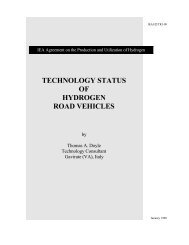Edited by Mary Rose de Valladares M.R.S. Enterprises, LLC ...
Edited by Mary Rose de Valladares M.R.S. Enterprises, LLC ...
Edited by Mary Rose de Valladares M.R.S. Enterprises, LLC ...
Create successful ePaper yourself
Turn your PDF publications into a flip-book with our unique Google optimized e-Paper software.
Several important projects are in<br />
operation to promote international<br />
collaboration. In the EU, SOLARH<br />
(Linking molecular genetics and bio<br />
mimetic chemistry – a multidisciplinary<br />
approach to achieve renewable<br />
hydrogen production) has been<br />
launched in SIXTH FRAMEWORK<br />
PROGRAMME of New and Emerging<br />
Science and Technology. In the project,<br />
EU countries such as France, Germany,<br />
The Netherlands, Hungary, Swe<strong>de</strong>n, and<br />
Switzerland have joined to cooperate.<br />
Nine (9) partners in seven (7) countries<br />
have joined Nordic BioHydrogen<br />
(Nordic Energy Research Program<br />
#2802). The Nordic BioHydrogen<br />
partners are: Norway, Swe<strong>de</strong>n, Iceland,<br />
Finland, Denmark, Estonia, and Latvia.<br />
COST 841 had been providing many<br />
meetings for researchers to join, even<br />
including nonEU countries such as<br />
the Baltics and Turkey. The US DOE<br />
BioHydrogen project and the Canadian<br />
NSERC BioHydrogen project are<br />
very active centers of research and<br />
information exchange for researchers<br />
in North America. Special growth in<br />
research and <strong>de</strong>velopments are also<br />
seen in Asia. The Korean national<br />
hydrogen project, Chinese practical<br />
research on BioHydrogen and biofuels,<br />
Taiwanese national hydrogen projects,<br />
and Japanese national BioHydrogen<br />
projects increase the number of<br />
BioHydrogen researchers in northeast<br />
the Asian High Technology Network,<br />
are occasionally held to accelerate<br />
BioHydrogen R&D in the region. The<br />
communication has been spreading<br />
to other Asian countries such as India,<br />
Singapore, and Thailand.<br />
Subtask A:<br />
BioHydrogen Systems<br />
The overall goal of this subtask<br />
is to increase achievable H 2 production<br />
from substrates above currently achiev<br />
able yields (3 to 4 moles H 2 /mole of<br />
glucose). The Netherlands is the activity<br />
lea<strong>de</strong>r.<br />
There are currently three BioHy<br />
drogen projects un<strong>de</strong>rway in Canada.<br />
production from cellulosic biomass,<br />
fun<strong>de</strong>d <strong>by</strong> NSERC (Natural Sciences<br />
and Engineering Research Council), and<br />
is being carried out <strong>by</strong> the University<br />
of Victoria and the University of Mani<br />
toba. Their work focuses on hydrogen<br />
fermentations <strong>by</strong> Clostridium thermocel<br />
lum, a highly active cellulose <strong>de</strong>grading<br />
thermophilic microorganism. Another<br />
project is being carried out at the Waste<br />
Technology Center of Environment<br />
Canada. They are looking at the copro<br />
duction of hydrogen and methane from<br />
simulated potato waste and at biological<br />
hydrogen production from anaerobic<br />
codigestion of organic MSW (Municipal<br />
Solid Waste) and sewage sludge. They<br />
have found that codigestion improves<br />
H2 production, perhaps because of an<br />
increase in buffer capacity of the organic<br />
MSW. A third project, Biological Hydro<br />
gen Production for Sustainable Energy<br />
Generation, fun<strong>de</strong>d <strong>by</strong> the joint NSERC/<br />
NRCan (Natural Resources Canada),<br />
is being carried out <strong>by</strong> the University<br />
of Montreal; they are also examining<br />
green house gas mitigation. Work was<br />
carried out to <strong>de</strong>termine the effect of<br />
culture conditions on hydrogen produc<br />
tion. Metabolic engineering is being<br />
to an introduced hydrogenase. Studies<br />
are also un<strong>de</strong>rway on the heterologous<br />
expression of hydrogenase.<br />
The BioHydrogen project in Japan<br />
It is fun<strong>de</strong>d <strong>by</strong> the Ministry of Agriculture<br />
Forestry and Fisheries, a part of the<br />
millennium foundation named Biomass<br />
Nippon. The project aims to <strong>de</strong>velop<br />
elemental technologies using microor<br />
ganisms in or<strong>de</strong>r to <strong>de</strong>gra<strong>de</strong> food waste<br />
and to regenerate energy as hydrogen,<br />
based on their physiological and engi<br />
neering aspects. This inclu<strong>de</strong>s a hybrid<br />
bioreactor with hydrogenmethane<br />
casca<strong>de</strong> fermentation, hydrogen produc<br />
tion un<strong>de</strong>r cocultivation with enteric and<br />
anoxygenic phototrophic bacteria, the<br />
33<br />
Subtask A:<br />
BioHydrogen<br />
Systems<br />
“The overall goal of<br />
this subtask is to<br />
increase achievable<br />
H 2 production from<br />
substrates above<br />
currently achievable<br />
yields (3 to 4 moles<br />
H 2 /mole of glucose).”<br />
Three BioHydrogen<br />
projects un<strong>de</strong>rway<br />
in Canada:<br />
• Coproduction<br />
of hydrogen<br />
and methane<br />
from simulated<br />
potato waste<br />
• Biological<br />
hydrogen production<br />
from anaerobic<br />
codigestion of<br />
organic MSW and<br />
sewage sludge<br />
• Biological<br />
Hydrogen Production<br />
for Sustainable<br />
Energy Generation<br />
Japanese<br />
Biohydrogen<br />
“Elemental<br />
technologies use<br />
microorganisms in<br />
or<strong>de</strong>r to <strong>de</strong>gra<strong>de</strong><br />
food waste and to<br />
regeneerate energy<br />
as hydrogen.”













